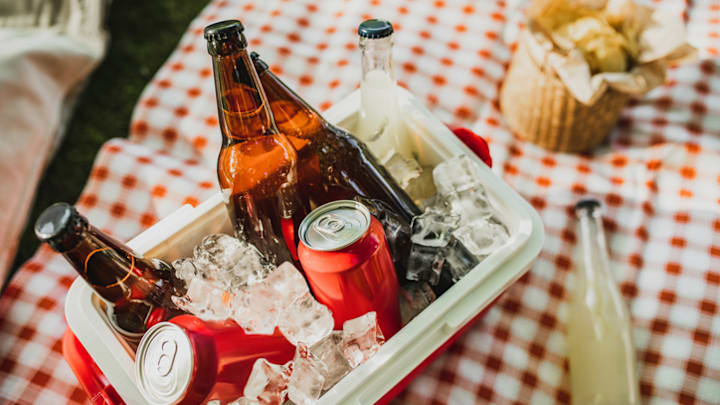American colonists of the Revolutionary War era hardly touched milk and water—not because they were exceptionally picky, but because there was a very good chance that milk or water would sicken anyone who drank them. Before pasteurization, cow’s milk teemed with bacteria, and river water could bring death in a pewter stein.
Early Americans consumed boiled-water drinks like coffee and tea, but they were imported at high cost and heavily taxed. So, for the most part, most people preferred stronger sources of hydration. That explains Benjamin Franklin’s dictionary of 200 synonyms for “being drunk,” including “been too free with Sir John Strawberry,” “nimptopsical,” and “lordly.” Here are a few Revolutionary War-era ideas for your old-timey Fourth of July party.
Small Beer
A person in the 18th century could drink all day and still have a functioning liver in middle age thanks to small beer. For centuries, Western civilizations had brewed beer containing only 2 to 4 percent alcohol, which was enough to make sure the water was safe to drink but not enough to cause drunkenness. Sugar plantations supported by enslaved labor in England’s Caribbean colonies produced molasses, from which American colonists brewed their small beer. (They were also quite fond of Caribbean rum.)
Cider
Molasses supplies dried up when the Revolutionary War began, and the British Navy blockaded colonial seaports to prevent trade with other countries. Americans had to come up with new sources of refreshment. Wine making never took off, but cider, made by pressing apples or peaches and allowing the juice to ferment, replaced a lot of the molasses-based drinks.
Corn Whiskey
Corn whiskey turned a widely grown and perishable crop into a shelf-stable liquor. Whiskey production helped the fledgling nation boost its domestic economy and wean itself from British imports. In the 1790s, George Washington’s distillery at Mount Vernon was producing 11,000 gallons of whiskey a year, and you can still buy modern iterations (made from rye) distilled using 18th-century methods.
Rattle-Skull
A delightfully named and appropriately lethal concoction from colonial New England, Rattle-Skull is a dark-hued drink best served in a large, chilled glass. The single-serving recipe from Anders Erickson shakes together 1 ounce rum, 1 ounce Cognac, half an ounce of demerara sugar syrup, and three-quarters of an ounce of lime juice with ice. Then, the mix is poured in the chilled glass containing an entire bottle of porter, which is finally garnished with grated nutmeg. Drink, then lie down for the rest of the day.
Fish House Punch
Fish House Punch is said to have originated around 1732 at the State in Schuylkill, a Philadelphia fishing club (that still exists) and was a included in a toast by George Washington. Punch is a social drink, and this authentic recipe from Tom Macy makes about 25 servings to be presented in a traditional bowl. It takes a full bottle of rum, 1.5 cups Cognac, a half-cup peach brandy, a quarter-cup peach liqueur, 2 cups lemon shrub (made by muddling lemon juice, sugar, and lemon peels), and at least 1 quart of cold water. This intense beverage is for true patriots only.
Ginger Beer
Ginger beer isn’t really beer—it is fermented, but not long enough to create alcohol—so drink up while you watch Fourth of July fireworks. An 18th-century recipe calls for 2 ounces of powdered ginger, half an ounce of cream of tartar, two sliced lemons, two pounds of loaf sugar, and two gallons of boiling water. Simmer these ingredients over medium heat for 30 minutes, then remove from the heat. When the liquid is cooled, stir in a tablespoon of yeast and let it ferment for 24 hours, after which it will be ready to drink.
Switchel
This sweet-tart drink, the Gatorade of the Revolutionary War era, staves off thirst with an electrolyte-heavy brew. It’s also called haymaker’s punch, alluding to its history of being served to farm workers after they come in hot and sweaty from the fields. A recipe from the Farmer’s Almanac calls for 1 gallon cold water, 1.5 cups molasses (or honey or maple syrup), one-third cup apple cider vinegar, and 1 tablespoon grated or minced fresh ginger. Combine, stir, and enjoy.
Discover More Old-Timey Food and Drink:
A version of this story was published in 2013; it has been updated for 2025.
